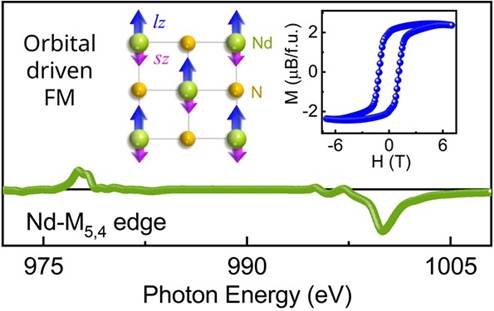Ministry of Science & Technology
Breakthrough in rare-earth magnetism promises more efficient quantum technologies
Posted On:
18 NOV 2025 5:05PM by PIB Delhi
Scientists have discovered a new kind of magnetism in a rare-earth compound that can be used in quantum and spintronic technologies. It envisions a new class of materials that can be tuned to design faster, more energy-efficient magnetic and quantum devices.
Rare-earth materials play a crucial role in modern technology, powering everything from electric vehicles and smartphones to wind turbines and defence systems. Among these, neodymium-based permanent magnets are indispensable due to their strong magnetic performance. However, until now, the magnetism in such materials was largely understood as being driven by the electron’s spin, the intrinsic property responsible for conventional ferromagnetism.
The study led by Jawaharlal Nehru Centre for Advanced Scientific Research (JNCASR), for the first time, demonstrated that single-crystalline grown thin films of neodymium nitride (NdN), exhibit ferromagnetism arising from the orbital angular momentum of electrons, marking a fundamental departure from conventional magnetic behaviour.
This landmark finding, published recently in ACS Nano (American Chemical Society), opens new possibilities in the emerging field of “orbitronics”, which aims to harness the orbital motion of electrons for future quantum and spintronic technologies.

Fig: NdN rock-salt crystal structure highlighting both spin and orbital angular momentum contributing significantly to magnetism, Magnetization-vs.-applied magnetic field measurement showing ferromagnetic hysteresis loop of an NdN thin film. X-ray magnetic circular dichroism at the Nd-M5,4 edges, demonstrating an orbital-driven net magnetic moment in NdN.
The team led by Prof. Bivas Saha from the JNCASR, Bengaluru, an autonomous institute of the Department of Science and Technology (DST) employed advanced thin-film growth and characterization techniques. This was complemented by electronic structure analysis, to reveal how crystal symmetry, electronic hybridization, and rare-earth orbital states together stabilize this unique orbital-driven magnetism.
“This discovery represents a paradigm shift in our understanding of magnetism,” said Prof. Bivas Saha, the corresponding author. “By controlling the orbital degrees of freedom, we can envision a new class of materials where both spin and orbital moments can be tuned to design faster, more energy-efficient magnetic and quantum devices.”
The study also highlights the magnetic anisotropy and electronic band structure of NdN, providing a fundamental framework for designing materials with strong orbital contributions to magnetism. The concept of orbitronics, much like spintronics, could pave the way for next-generation information and memory technologies that go beyond the limits of spin-based devices.
The discovery is particularly timely as global competition over rare-earth materials intensifies. Neodymium, a key component in high-performance magnets, is among the most strategic materials in the clean-energy and defence sectors. India, with nearly 8% of the world’s rare-earth reserves, is well positioned to contribute to this critical area of materials innovation.
In addition to JNCASR, researchers from IISER Thiruvananthapuram and the Raja Ramanna Centre for Advanced Technology, Indore, as well as from DESY (Germany) and ALBA (Spain), contributed to this collaborative effort. The other researchers involved include
Renuka Karanje, Anupam Bera, Sourav Rudra, Debmalya Mukhopadhyay, Souvik Banerjee, Manisha Bansal, Kiran Baraik, Sourav Chowdhury, Weibin Li, Manuel Valvidares and Tuhin Maity.
Link to publication: https://pubs.acs.org/doi/full/10.1021/acsnano.5c11890
****
NKR/AK
(Release ID: 2191258)
Visitor Counter : 272